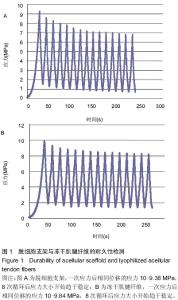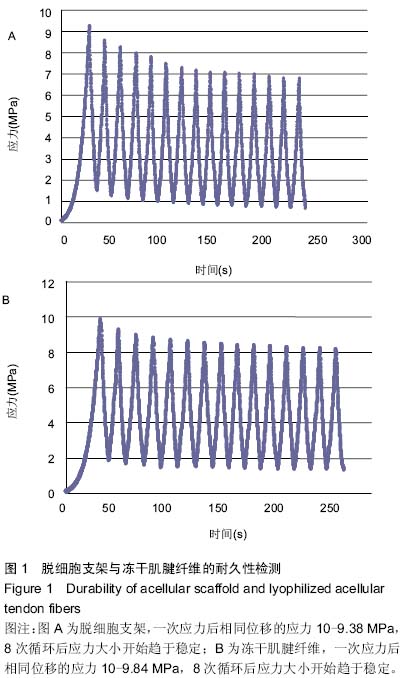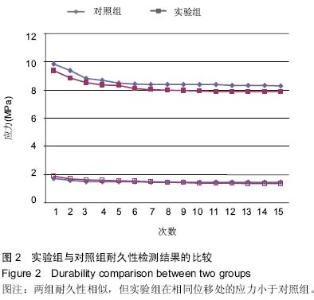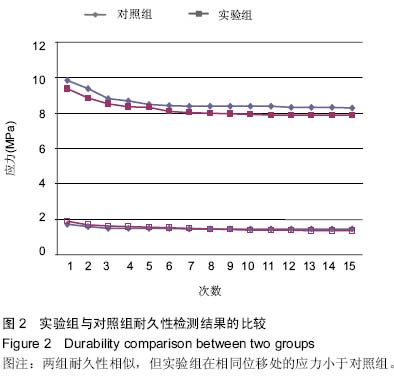Chinese Journal of Tissue Engineering Research ›› 2015, Vol. 19 ›› Issue (30): 4865-4869.doi: 10.3969/j.issn.2095-4344.2015.30.021
Previous Articles Next Articles
Biomechanical properties of a decellularized scaffold of lyophilized bovine tendon
Qian Chuang1, Chen Xiong-sheng2, Zhou Sheng-yuan2, Zhu Wei2
- 1Second Military Medical University, Shanghai 200003, China;
2Third Department of Spinal Cord, Changzheng Hospital of Second Military Medical University, Shanghai 200003, China
-
Online:2015-07-16Published:2015-07-16 -
Contact:Chen Xiong-sheng, Professor, Third Department of Spinal Cord, Changzheng Hospital of Second Military Medical University, Shanghai 200003, China -
About author:Qian Chuang, Studying for master’s degree, Second Military Medical University, Shanghai 200003, China
CLC Number:
Cite this article
Qian Chuang, Chen Xiong-sheng, Zhou Sheng-yuan, Zhu Wei. Biomechanical properties of a decellularized scaffold of lyophilized bovine tendon[J]. Chinese Journal of Tissue Engineering Research, 2015, 19(30): 4865-4869.
share this article
| [1] Sachs RA,Daniel DM,Stone ML,et al.Patellofemoral problems after anterior cruciate ligament reconstruction.Am J Sports Med.1989;17(6):760-765. [2] Caruso AB,Dunn MG.Changes in mechanical properties and cellularity during long-term culture of collagen fiber ACL reconstruction scaffolds.J Biomed Mater Res A.2005;73(4): 388-397. [3] Weadock KS,Miller EJ,Keuffel EL,et al.Effect of physical crosslinking methods on collagen-fiber durability in proteolytic solutions.J Biomed Mater Res.1996;32(2):221-226. [4] Benders KE,Weeren PR,Badylak SF,et al.Extracellular matrix scaffolds for cartilage and bone regeneration.Trends Biotechnol. 2013;31(3):169-176. [5] Chen J,Xu J,Wang A,et al.Scaffolds for tendon and ligament repair: review of the efficacy of commercial products.Expert Rev Med Devices.2009;6(1):61-73. [6] 朱巍,贾连顺.韧带和肌腱修复的基因治疗进展[J].中华创伤杂志,2007,23(10):798-800. [7] Ivanov AN,Norkin IA,Puchin'Ian DM.The possibilities and perspectives of using scaffold technology for bone regeneration.Tsitologiia.2014;56:543-548. [8] Mcdevitt CA,Wildey GM,Cutrone RM.Transforming growth factor-beta1 in a sterilized tissue derived from the pig small intestine submucosa.J Biomed Mater Res A.2003;67(2): 637-640. [9] Kim KS,Lee JY,Kang YM,et al.Small intestine submucosa sponge for in vivo support of tissue-engineered bone formation in the presence of rat bone marrow stem cells. Biomaterials.2010;31(6):1104-1113. [10] Jr Bach B,Aadalen KJ,Dennis MG,et al.Primary anterior cruciate ligament reconstruction using fresh-frozen, nonirradiated patellar tendon allograft: minimum 2-year follow-up.Am J Sports Med.2005;33(2):284-292. [11] Prodromos C,Joyce B,Shi K.A meta-analysis of stability of autografts compared to allografts after anterior cruciate ligament reconstruction.Knee Surg Sports Traumatol Arthrosc.2007;15(7):851-856. [12] Bosch U,Kasperczyk WJ.Healing of the patellar tendon autograft after posterior cruciate ligament reconstruction--a process of ligamentization? An experimental study in a sheep model.Am J Sports Med.1992;20(5):558-566. [13] Jackson DW,Grood ES,Goldstein JD,et al.A comparison of patellar tendon autograft and allograft used for anterior cruciate ligament reconstruction in the goat model. Am J Sports Med.1993;21(2):176-185. [14] Snyder CC.On the history of the suture. Plastic Reconstruct Surg.1976;58:401-406. [15] Getzen LC,Jansen GA.Correlation between allergy to suture material and postoperative wound infections. Surgery.1966; 60:824-826. [16] Daly KA,Stewart-Akers AM,Hara H,et al.Effect of the a Gal epitope on the response to small intestinal submucosa extracellular matrix in a nonhuman primate model.Tissue Eng Part A.2009;15:3877-3888. [17] Goldstein S,Clarke DR,Walsh SP,et al.Transpecies heartvalve transplant: advanced studies of a bioengineered xenoautograft.Ann Thorac Surg.2000;70:1962-1969. [18] Daly KA,Stewart-Akers AM,Hara H,et al.Effect of the a Gal epitope on the response to small intestinal submucosa extracellular matrix in a nonhuman primate model.Tissue Eng Part A.2009;15:3877-3888. [19] Gilbert TW,Freund JM,Badylak SF.Quantification of DNA in biologic scaffold materials.J Surg Res.2009;152:135-139. [20] Xu H,Wan H,Zuo W,et al.A porcine-derived acellular dermal scaffold that supports soft tissue regeneration: removal of terminal galactose-a-(1, 3)-galactose and retention of matrix structure.Tissue Eng Part A.2009;15:1807-1819. [21] Keane TJ,Londono R,Turner NJ,et al.Consequences of ineffective decellularization of biologic scaffolds on the host response.Biomaterials.2012;33:1771-1781. [22] Tedder ME,Simionescu A,Chen J,et al.Assembly and testing of stem cell-seeded layered collagen constructs for heart valve tissue engineering.Tissue Eng Part A.2010;17:25-36. [23] Böer U,Lohrenz A,Klingenberg M,et al.The effect of detergent-based decellularization procedures on cellular proteins and immunogenicity in equine carotid artery grafts. Biomaterials.2011;32:9730-9737. [24] Sellaro TL,Ranade A,Faulk DM,et al.Maintenance of human hepatocyte function in vitro by liver-derived extracellular matrix gels. Tissue Eng Part A.2009;16:1075-1082. [25] Ross EA,Abrahamson DR,St John P,et al.Mouse stem cells seeded into decellularized rat kidney scaffolds endothelialize and remodel basement membranes. Organogenesis. 2012; 8(2):49-55. [26] Aurora A,Mccarron J,Iannotti JP,et al.Commercially available extracellular matrix materials for rotator cuff repairs: state of the art and future trends. J Shoulder Elbow Surg.2007;16(5 Suppl):S171-S178. [27] Saha P,Manna S,Chowdhury SR,et al. Enhancement of tensile strength of lignocellulosic jute fibers by alkali-steam treatment.Bioresour Technol.2010;101(9):3182-3187. [28] Gentleman E,Lay AN,Dickerson DA,et al.Mechanical characterization of collagen fibers and scaffolds for tissue engineering.Biomaterials.2003;24(21):3805-3813. [29] Whitlocka PW,Smitha TL,Poehlinga GG,et al.A naturally derived, cytocompatible, and architecturally optimized scaffold for tendon and ligament regeneration. Biomaterials. 2007;28:4321-4329. [30] Ingram JH,Korossis S,Howling G,et al.The use of ultrasonication to aid recellularization of acellular natural tissue scaffolds for use in anterior cruciate ligament reconstruction.Tissue Eng.2007; 13(7):1561-1572. [31] Gratzer PF,Harrison RD,Woods T.Matrix alteration and not residual sodium sulfate cytotoxicity affects the cellular repopulation of a decellularized matrix.Tissue Eng. 2006; 12(10):2975-2983. [32] Woods T,Gratzer PF.Effectiveness of three extraction techniques in the development of a decellularized bone-anterior cruciate ligament-bone graft. Biomaterials.2005; 26:7339-7349. [33] Gilbert TW,Sellaro TL,Badylaka SF.Decellularization of tissues and organs. Biomaterials.2006;27(19):3675-3683. [34] 高峰,杨有庚,马洪顺.髂股韧带与股骨头韧带的拉伸力学性质[J].中国组织工程研究与临床康复,2008,12(26):5105-5108. [35] Spalazzi JP,Dagher E,Doty SB,et al.In vivo evaluation of a multiphased scaffold designed for orthopaedic interface tissue engineering and soft tissue-to-bone integration.J Biomed Mater Res A.2008;86(1):1-12. |
| [1] | Chen Ziyang, Pu Rui, Deng Shuang, Yuan Lingyan. Regulatory effect of exosomes on exercise-mediated insulin resistance diseases [J]. Chinese Journal of Tissue Engineering Research, 2021, 25(25): 4089-4094. |
| [2] | Chen Yang, Huang Denggao, Gao Yuanhui, Wang Shunlan, Cao Hui, Zheng Linlin, He Haowei, Luo Siqin, Xiao Jingchuan, Zhang Yingai, Zhang Shufang. Low-intensity pulsed ultrasound promotes the proliferation and adhesion of human adipose-derived mesenchymal stem cells [J]. Chinese Journal of Tissue Engineering Research, 2021, 25(25): 3949-3955. |
| [3] | Yang Junhui, Luo Jinli, Yuan Xiaoping. Effects of human growth hormone on proliferation and osteogenic differentiation of human periodontal ligament stem cells [J]. Chinese Journal of Tissue Engineering Research, 2021, 25(25): 3956-3961. |
| [4] | Sun Jianwei, Yang Xinming, Zhang Ying. Effect of montelukast combined with bone marrow mesenchymal stem cell transplantation on spinal cord injury in rat models [J]. Chinese Journal of Tissue Engineering Research, 2021, 25(25): 3962-3969. |
| [5] | Gao Shan, Huang Dongjing, Hong Haiman, Jia Jingqiao, Meng Fei. Comparison on the curative effect of human placenta-derived mesenchymal stem cells and induced islet-like cells in gestational diabetes mellitus rats [J]. Chinese Journal of Tissue Engineering Research, 2021, 25(25): 3981-3987. |
| [6] | Hao Xiaona, Zhang Yingjie, Li Yuyun, Xu Tao. Bone marrow mesenchymal stem cells overexpressing prolyl oligopeptidase on the repair of liver fibrosis in rat models [J]. Chinese Journal of Tissue Engineering Research, 2021, 25(25): 3988-3993. |
| [7] | Liu Jianyou, Jia Zhongwei, Niu Jiawei, Cao Xinjie, Zhang Dong, Wei Jie. A new method for measuring the anteversion angle of the femoral neck by constructing the three-dimensional digital model of the femur [J]. Chinese Journal of Tissue Engineering Research, 2021, 25(24): 3779-3783. |
| [8] | Meng Lingjie, Qian Hui, Sheng Xiaolei, Lu Jianfeng, Huang Jianping, Qi Liangang, Liu Zongbao. Application of three-dimensional printing technology combined with bone cement in minimally invasive treatment of the collapsed Sanders III type of calcaneal fractures [J]. Chinese Journal of Tissue Engineering Research, 2021, 25(24): 3784-3789. |
| [9] | Qian Xuankun, Huang Hefei, Wu Chengcong, Liu Keting, Ou Hua, Zhang Jinpeng, Ren Jing, Wan Jianshan. Computer-assisted navigation combined with minimally invasive transforaminal lumbar interbody fusion for lumbar spondylolisthesis [J]. Chinese Journal of Tissue Engineering Research, 2021, 25(24): 3790-3795. |
| [10] | Hu Jing, Xiang Yang, Ye Chuan, Han Ziji. Three-dimensional printing assisted screw placement and freehand pedicle screw fixation in the treatment of thoracolumbar fractures: 1-year follow-up [J]. Chinese Journal of Tissue Engineering Research, 2021, 25(24): 3804-3809. |
| [11] | Shu Qihang, Liao Yijia, Xue Jingbo, Yan Yiguo, Wang Cheng. Three-dimensional finite element analysis of a new three-dimensional printed porous fusion cage for cervical vertebra [J]. Chinese Journal of Tissue Engineering Research, 2021, 25(24): 3810-3815. |
| [12] | Wang Yihan, Li Yang, Zhang Ling, Zhang Rui, Xu Ruida, Han Xiaofeng, Cheng Guangqi, Wang Weil. Application of three-dimensional visualization technology for digital orthopedics in the reduction and fixation of intertrochanteric fracture [J]. Chinese Journal of Tissue Engineering Research, 2021, 25(24): 3816-3820. |
| [13] | Sun Maji, Wang Qiuan, Zhang Xingchen, Guo Chong, Yuan Feng, Guo Kaijin. Development and biomechanical analysis of a new anterior cervical pedicle screw fixation system [J]. Chinese Journal of Tissue Engineering Research, 2021, 25(24): 3821-3825. |
| [14] | Lin Wang, Wang Yingying, Guo Weizhong, Yuan Cuihua, Xu Shenggui, Zhang Shenshen, Lin Chengshou. Adopting expanded lateral approach to enhance the mechanical stability and knee function for treating posterolateral column fracture of tibial plateau [J]. Chinese Journal of Tissue Engineering Research, 2021, 25(24): 3826-3827. |
| [15] | Zhu Yun, Chen Yu, Qiu Hao, Liu Dun, Jin Guorong, Chen Shimou, Weng Zheng. Finite element analysis for treatment of osteoporotic femoral fracture with far cortical locking screw [J]. Chinese Journal of Tissue Engineering Research, 2021, 25(24): 3832-3837. |
| Viewed | ||||||
|
Full text |
|
|||||
|
Abstract |
|
|||||



